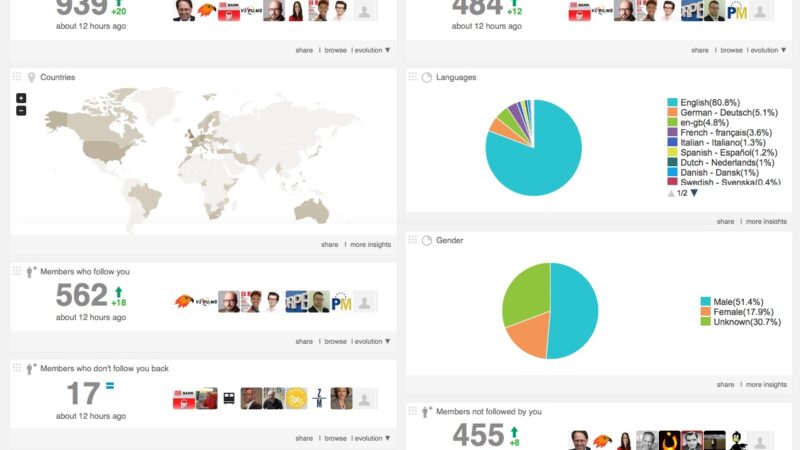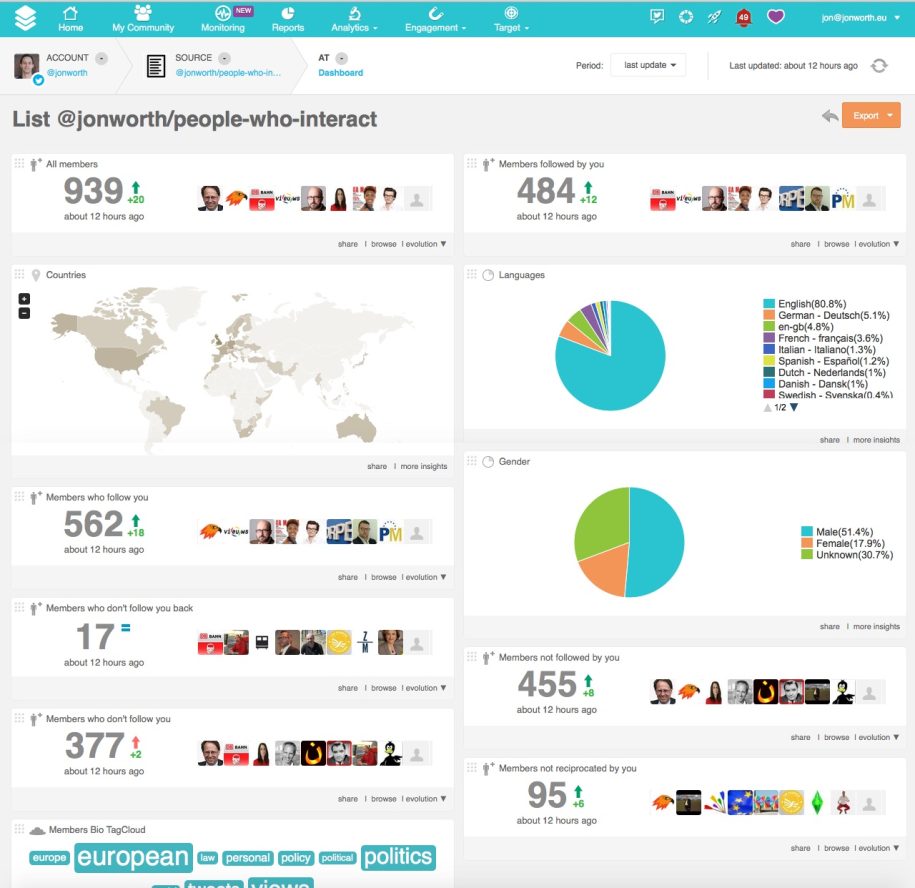Few people are interacting on Twitter (and those who are aren’t the ones you’d expect)

On 18 May (18 days ago) I started a little experiment. Using SocialBro I started a private Twitter list called People Who Interact. This list was automatically created – out of everyone who either replied to a tweet I wrote, or RTed a tweet of mine. The summary of the results – a screenshot from SocialBro – is here:
 Some elements of this are worth examining in some depth.
Some elements of this are worth examining in some depth.
- I have 14261 followers at the time of writing on Twitter, and I write 186 tweets per week (according to FollowerWonk) – so 27 tweets per day. 52.5% of my tweets are @-replies, so about 13 of my daily tweets (or about 227 tweets across the whole 18 day period) will theoretically reach all the 14261 followers.
- My tweets have generated interactions – either replies or RTs – from 939 different users over that period. However only 562 of those users are people that actually follow me. 377 of them are people that do not follow me – that’s genuinely interesting, and far higher than I would have imagined. However the stat among my followers is more depressing – a measly 3.94% of the people who follow me actually had some sort of meaningful engagement with my tweets over an 18 day period.
- Don’t trust the gender statistic in the graph above – I have debated this at length on Twitter a number of times, and no-one can work out whether these stats are actually reliable.
All of this seems to confirm my intuition that my tweets get less and less effective – that tweeting things feels like tweeting into the ether, and getting decent debates and engagement going with an audience beyond my EU politics core people gets harder and harder. I’ll keep the experiement going for a while longer to see if and when the picture changes, but don’t hold your breath – as Twitter gets more and more commercial, and less and less equal, my fear is that this problem will only worsen further.
[UPDATE 10.7.2015]
Now the total number of people I have had interactions with on Twitter has reached 1800. Of these, 977 follow me and 822 do not. I follow 786 of these 1800 people, and do not follow 1013 of them. The problem very much remains the same as I have outlined above – just 6.74% of the people who follow me have in any way engaged with me in the 53 days since I started this experiment. So much for Twitter being interactive!
Anyway, in a formal sense I am going to now end this experiment – I will keep the list running, but I will actively use it to find potentially new and interesting people to follow. That might help my Twitter use, but will render the stats for the experiment less relevant.
@jon
I think you comment “The problem is that many I would like to debate with (also in a civilised manner) never reply, and ones I might once in a while like to hear from do not interact either. ” actually sum up the problems with Twitter as a concept.
Twitter is very much a peer to peer communication platform and as such it suffers from what probably could call “the school playground syndrome”. The problem is the people who you want as your peers are not necessarily the people who want you as a peer, meanwhile the people who think of you as their peer are actually are frankly annoying buffoons seeking an argument or confirmation of their beliefs.
Once I realised that my life on twitter wasn’t going to be spent hobnobbing with the cool journalistic elite (David Aaronovitch, Dan Hodges, Nick Cohen, Danny Finkelstein etc) and probably was going to be spent getting into futile arguments with mindless bigots I realised it was essentially a worthless tool and a waste of my limited time.
I like the idea of influencing things and making things better. But the reality is for most of us who don’t media profile (or time to build a social media profile) twitter is simply a futile exercise of shouting opinions into the void!
@tst – I agree with you that sort of shrill, extreme sort of view is very prevalent on Twitter, but I am not altogether sure it needs to be that way, does it? I could get drawn into fights about pro-EU vs. euroscepticism, but what’s the point, actually? I can have very decent debates on Twitter with a fair number of people (including ones I disagree with in a civilised manner). The problem is that many I would like to debate with (also in a civilised manner) never reply, and ones I might once in a while like to hear from do not interact either. To put it another way, I’d like to be able to expand the good, interesting, edgy aspects of Twitter I like and have more people in that circle, and fewer in the annoying ranters part.
The problem with twitter is it is full of activists (be they left wing or right wing) is that they are completely unrepresentative of the population as a whole. They hold stronger opinions and tend to hold more knowledge (although whether the knowledge is balance enough to lead to an well balanced and informed opinion is often very questionable). Meanwhile most other people on most issues fall into categories: –
– Ambivalent (aware they don’t know enough or simply ambivalent
– Reactive and reactionary (whipped up by inflammatory reporting or framing of an issue).
Twitter has become a place full of activists often with very partisan view, trying (and often succeeding) to frame the debate to whip up opinion. Its become the natural home of nationalists and reactionaries (hence Cybernats, Corbynistas and even – at its worst – CyberJihadis). Its a terrible place if you want balanced and informed opinion and its probably why sensible people keep off it and engagement is going down. Most people don’t want to be lead by the mob and equally most people don’t have time or energy to inform themselves (which is why most people don’t read broadsheets). Hence most people don’t bother with twitter (or if they do its to do something more sensible like follow their favourate popstar or actor).
I’m really not a twitter enthusiast but I noticed on different accounts that twitter actions rise if they post infrequently.